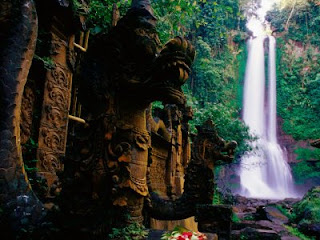Senaru Village is the main access to
Mt. Rinjani National Park, and the most popular starting point for trekking to the second highest peak in Indonesia. with in Segara Anak lake as the destination of many pilgrims who place offering in the water and bathe away diseas in the hot springs.
The cool, flower filled mountain village stretching along a hill side spur above Bayan. The village of Senaru is an easy 2,5 hours drive from Mataram and Senggigi, Senaru has range of accommodations in simple pretty home stays (Losmen), and a number of cafes serving delicious local specialties with lovely views.
The National Park and village entrance fee are here. Village guide including several local women wo has trained to acompany visitors for sigh seeing around the village. Arrange a guided exchurchion through Sembilan Pulau Tour.
WaterfallSenaru’s best known attraction is the Sendang Gila waterfall which attracts many thousands of Indonesian and foreign visitors annually.
Located at about 600m above sea level, the waterfall is an easy 20 minute walk down a graded trail and steps from Senaru Village, a pleasant alternative return route winds along the edge of the steep valley, following the irrigation canal.
For the more adventurous, Senaru’s “second waterfall” Tiu Kelep is another hour’s walk upriver from Sendang Gila. The scramble over rocks through the tropical forest is rewarded by the beauty of the waterfall and a swim in its deep pool. It is said locally that every time you swim behind the main waterfall of Tiu Kelep you become a year younger!
With access from the main road, Senaru’s “third waterfall” Betara Lenjang is a true rainforest adventure strictly for rock climbers with local guide and equipment.
WildlifeDuring early morning and evening walks in Senaru you are likely to see interesting birds, butterflies and at least one of the two species of monkey who live in the surrounding forest. Long tail macaques, known locally as kera, often seat on the road.
More elusive is the rare Silvered Leaf monkey, and also known as the black monkey or Lutung, which can often be glimpsed in the forest around the waterfalls.
Senaru Traditional VillageA visit to the Senaru Traditional Village, situated next to Rinjani Trek Center where the Rinjani trail begins, is greatly enhanced by asking a local guide to show you around. The Sasak inhabitants are the cultural guardians of Mount Rinjani and its surrounding forest and safeguard its spiritual values. Locally guided visits include opportunities to experience the villagers daily life, visit their thatched houses and gardens of fruits and spices.
For a romantic highlight, ask to be shown the “sunset view” where you may see the tropical sun setting against the distant skyline of Bali.
Cultural PerformancesBy special request in advance, the people of Senaru and Sembalun can treat you to the very special spectacle of their traditional music and dance performances in a village setting beneath
Mt. Rinjani.
Sembalun Lawang is set an ancient an fertile caldera to the east of Mount Rinjani, preferred access route for summiteers. The rich soil produces high quality market garden crops, including the famous garlic and rice, staple of local farmers. Seismic activity is monitored daily at government Rinjani Volcano logy centre. The beautiful valley of Sembalun is also known for its hill walks, recently restore traditional village, active cultural performers and local weavers. Some home stay (Losmen) accommodation is available and trek service are based at park’s Rinjani Information Centre.
Women hand-loom weavers in the village of Sembalun Lawang, East Lombok have recently revived their weaving skills with the help of the NZAID Rinjani Trek Ecotourism Programme. The women decided they would like to return to this ancient craft after many years of earning a livelihood by other means. They now work together in co-operative groups sharing skills and resources.
In the past weaving was an essential qualification for womanhood, and young girls began to learn the basic skills at an early age. All women were expected to provide their family with fabrics for clothing and ceremonial use. Now, with the widespread availability of factory-made fabrics, hand-loom textiles are used mostly for religious ceremonies and special occasions such as weddings.
Although the weavers no longer spin and dye local cotton to make their yarns, the weaving process is nevertheless very labour intensive. The fine yarns must be washed, threaded onto the loom and wound onto bobbins before weaving can start a process which can take several days. Once the looms are set up it takes about a week to complete a length of this stunning cloth. It may be sold as is, or sewn into place mats, bags, cushion covers and belts. All the work is done in the village by local women.
The rich colours are achieved by careful selection and blending of basic yarn colours available from the textile mills of Java. These women are masters of colour and the simple, modern motifs they now use show this skill off to great advantage.






















